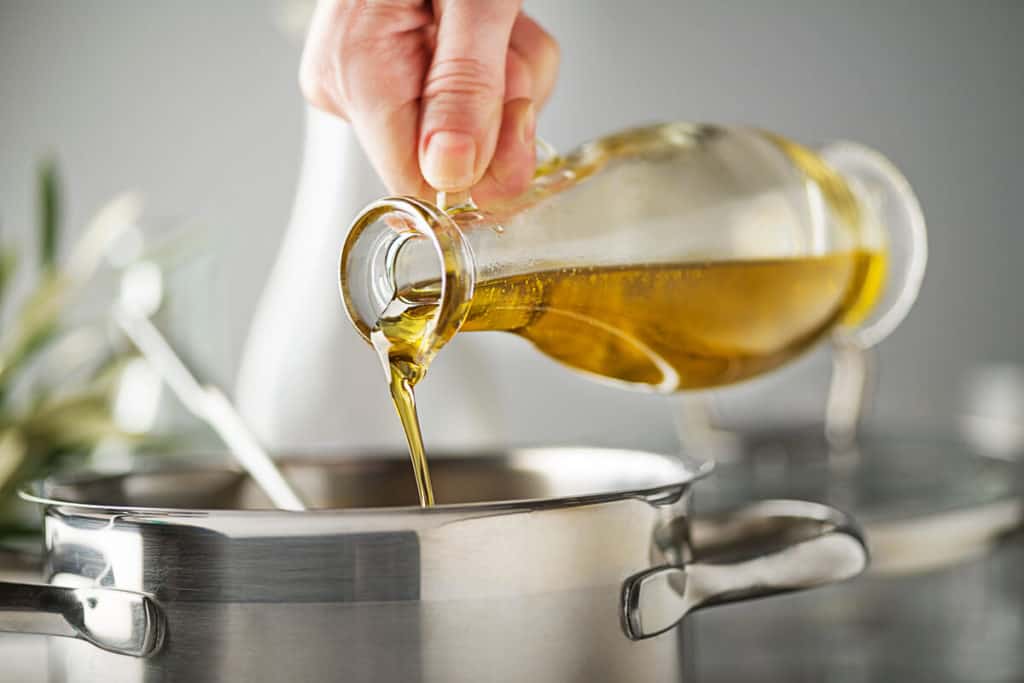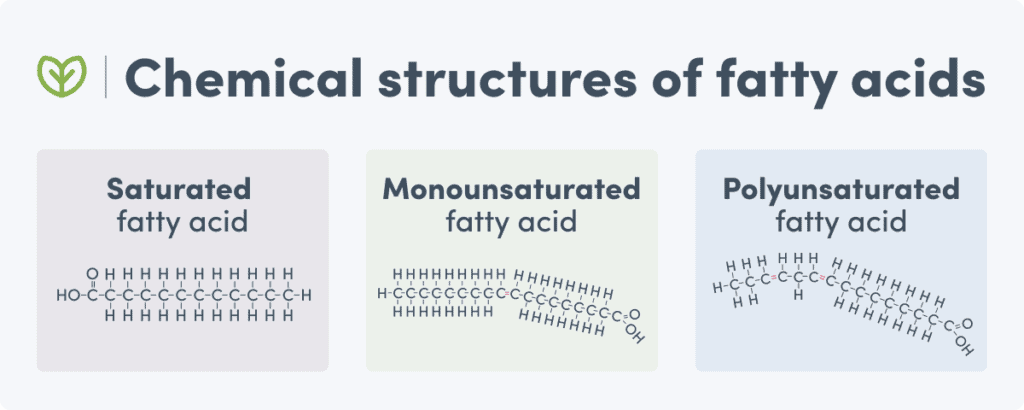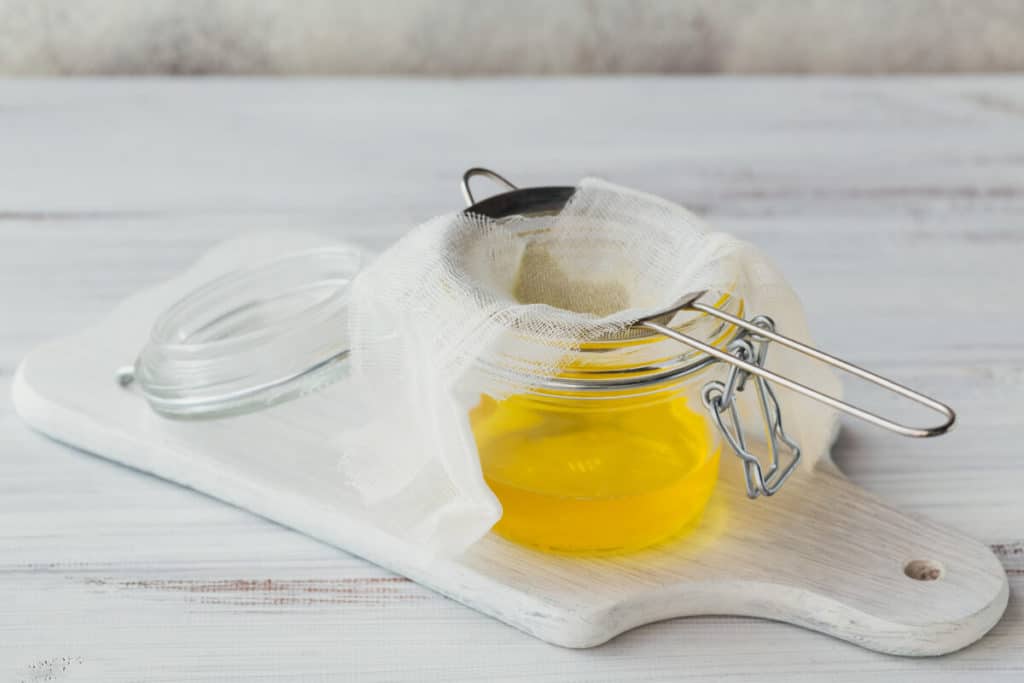
What makes an oil safe for cooking?
When we talk about the healthiest cooking oils and fats, it’s important to understand the concept of oxidation and fat stability. (5) When an oil is exposed to heat, oxygen, or light, a process known as oxidation and the subsequent production of potentially harmful free radicals may occur. (11) Free radicals are harmful compounds that have been linked to many health conditions, such as cardiovascular disease, inflammatory joint disease, and chronic digestive conditions. (10) An oil’s resistance to oxidation is determined primarily by the saturation of the fatty acids found in an oil. (11) “Smoke point” is the term often used to describe the temperature at which an oil starts to oxidize, losing its integrity and releasing free radicals. (26)
Did you know? While saturated fats have been demonized for years, more recent studies have questioned claims citing saturated fat’s negative health effects, particularly related to cardiovascular disease. (6)(16)(27)(31)
What is the healthiest cooking oil?: Top 4 best oils to cook with
While polyunsaturated fatty acids offer a range of important health benefits, saturated and monounsaturated fats are better for high heat cooking as a result of their more stable nature. Summarized below are four of the top fats to use in the kitchen for cooking such as roasting and sautéing.
Virgin coconut oil
Virgin coconut oil tops the list of safe cooking oils with a fatty acid composition of 90% saturated fatty acids, a large portion of which being lauric acid. (14) Lauric acid found in virgin coconut oil has been shown to reduce low-density lipoprotein (LDL) oxidation, a contributing factor to cardiovascular disease. (18) Not only has coconut oil been shown to protect against cardiovascular disease, but the medium-chain triglycerides (MCT) found in coconut oil may increase metabolism and feelings of satiety (fullness) between meals, suggesting it can be helpful in maintaining a healthy weight. (2)(34) There is no shortage of ways to use coconut oil for cooking. including weeknight curries, veggie-packed stir fries, and healthy baked goods. Saturated fatty acid content: 91% Monounsaturated fatty acid content: 7% Polyunsaturated fatty acid content: 2% (21)Avocado oil
It’s hard to go wrong when using avocado oil for cooking. Avocado oil is rich in oleic acid, a beneficial monounsaturated fatty acid that is also found in olive oil. (24) Heart healthy oleic acid has been shown to reduce blood pressure by regulating the lipid membrane structure. (33) The ratio of monounsaturated fatty acids to saturated fatty acids found in avocado oil makes it great for high heat cooking, such as roasting and frying your favorite vegetables. (4) Saturated fatty acid content: 12% Monounsaturated fatty acid content: 74% Polyunsaturated fatty acid content: 14% (22)
Grass-fed butter and ghee
For years, butter was demonized for its saturated fat content and replaced with margarine, which was believed to be a healthier, heart healthy alternative. As it turns out, butter isn’t so bad after all, and margarine is the one to avoid as research suggests that this butter alternative may be the one of the contributing inflammatory factors to coronary heart disease. (9) Butter made specifically from grass-fed cattle is rich in conjugated linoleic acid (CLA), which has been shown to have notable health benefits. CLA has been studied for its anticancer properties, suppressing the development of cancerous tumors in vivo and in vitro. (12)(15) CLA has also been shown to have a beneficial effect on immunity and inflammation. (25)(32) Research has demonstrated CLA’s ability to decrease levels of proteins involved in the inflammatory process, specifically in male athletes. (17) Butter is also rich in butyrate, a short-chain fatty acid that is also produced by the beneficial bacteria in our guts as a source of energy for intestinal cells. (8) Butyrate supports optimal digestive health and has been shown to decrease symptoms related to irritable bowel syndrome (IBS), such as abdominal pain, bloating, and constipation. (36) The research also suggests that butyrate may have anti-inflammatory effects in patients with Crohn’s disease, a condition characterized by inflammation of the digestive tract, leading to symptoms such as abdominal pain and digestive discomfort. (29) Keep in mind is that the sugars and protein found in butter can burn when heating them at high temperatures—that’s where ghee comes in. Ghee, a type of clarified butter, is made by removing the milk solids from the butter, leaving just the butterfat behind, creating a more stable, nutrient-dense cooking oil option. (30) Saturated fatty acid content: 68% Monounsaturated fatty acid content: 28% Polyunsaturated fatty acid content: 4% (20)Extra-virgin olive oil
Extra virgin olive oil (EVOO) is a key component of the Mediterranean diet and has had a welcome spot in our pantries for years. EVOO is high in heart healthy oleic acid, much like avocado oil. It is also another kitchen staple that keeps its integrity and nutritional value when exposed to heat. (1)(4) The monounsaturated fatty acids found in EVOO help to lower triglyceride levels, and its antioxidants can reduce arterial stress and support arterial cell function. (19) From sautéing leafy greens to roasting vegetables, using olive oil for cooking provides a nutritious and healthy source of fat. Saturated fatty acid content: 14% Monounsaturated fatty acid content: 75% Polyunsaturated fatty acid content: 11% (23)Cooking oils to avoid
Although seed oils like hemp and flaxseed oil are stable at room room temperature, their high polyunsaturated fatty acid profiles make them susceptible to oxidation when exposed to heat. (11) It is also recommended to stay away from highly processed vegetable oils, such as canola and corn oil, which have been linked to the development of numerous health conditions, including cancer and heart disease. (7)(28)The bottom line
Using healthy, heat-stable cooking oils in everyday cooking can be a great way to add flavor and a dose of healthy fats to meals. Coconut oil, avocado oil, butter or ghee, and olive oil are all excellent choices for culinary cooking purposes based on their fatty acid and nutrition profile. It’s important to reserve oils high in polyunsaturated fatty acids that oxidize easily such as flax and hemp seed oil for low heat food preparation such as salad dressings.- Allouche, Y., Jiménez, A., Gaforio, J. J., Uceda, M., & Beltrán, G. (2007). How heating affects extra virgin olive oil quality indexes and chemical composition. Journal of Agricultural and Food Chemistry, 55(23), 9646–9654.
- Assunção, M. L., Ferreira, H. S., dos Santos, A. F., Cabral, C. R., & Florêncio, T. M. M. T. (2009). Effects of dietary coconut oil on the biochemical and anthropometric profiles of women presenting abdominal obesity. Lipids, 44(7), 593–601.
- Bentsen, H. (2017). Dietary polyunsaturated fatty acids, brain function and mental health. Microbial Ecology in Health and Disease, 28, 1281916.
- Berasategi, I., Barriuso, B., Ansorena, D., & Astiasarán, I. (2012). Stability of avocado oil during heating: Comparative study to olive oil. Food Chemistry, 132(1), 439–446.
- Chaiyasit, W., Elias, R. J., McClements, D. J., & Decker, E. A. (2007). Role of physical structures in bulk oils on lipid oxidation. Critical Reviews in Food Science and Nutrition, 47(3), 299–317.
- Chowdhury, R., Warnakula, S., Kunutsor, S., Crowe, F., Ward, H. A., Johnson, L., Franco, O. H., Butterworth, A. S., Forouhi, N. G., Thompson, S. G., Khaw, K.-T., Mozaffarian, D., Danesh, J., & Di Angelantonio, E. (2014). Association of dietary, circulating, and supplement fatty acids with coronary risk. Annals of Internal Medicine, 160(6), 398.
- de Lorgeril, M., & Salen, P. (2012). New insights into the health effects of dietary saturated and omega-6 and omega-3 polyunsaturated fatty acids. BMC Medicine, 10(1), 50.
- Donohoe, D. R., Garge, N., Zhang, X., Sun, W., O’Connell, T. M., Bunger, M. K., & Bultman, S. J. (2011). The microbiome and butyrate regulate energy metabolism and autophagy in the mammalian colon. Cell Metabolism, 13(5), 517–526.
- Gillman, M. W., Cupples, L. A., Gagnon, D., Millen, B. E., Ellison, R. C., & Castelli, W. P. (1997). Margarine intake and subsequent coronary heart disease in men. Epidemiology, 8(2), 144–149.
- Grootveld, M., Silwood, C. J. L., Addis, P., Claxson, A., Serra, B. B., & Viana, M. (2001). Health effects of oxidized heated oils. Foodservice Research International, 13(1), 41–55.
- Ismail, A., Bannenberg, G., Rice, H. B., Schutt, E., & MacKay, D. (2016). Oxidation in EPA‐ and DHA‐rich oils: an overview. Lipid Technology, 28(3–4), 55–59.
- Kelley, N. S., Hubbard, N. E., & Erickson, K. L. (2007). Conjugated linoleic acid isomers and cancer. The Journal of Nutrition, 137(12), 2599–2607.
- Kendall, A. C., Kiezel-Tsugunova, M., Brownbridge, L. C., Harwood, J. L., & Nicolaou, A. (2017). Lipid functions in skin: Differential effects of n-3 polyunsaturated fatty acids on cutaneous ceramides, in a human skin organ culture model. Biochimica et Biophysica Acta (BBA) – Biomembranes, 1859(9), 1679–1689.
- Kostik, V., Memeti, S., & Bauer, B. (2013). Fatty acid composition of edible oils and fats. Journal of Hygienic Engineering and Design, 4, 112–116.
- Lee, K. W., Lee, H. J., Cho, H. Y., & Kim, Y. J. (2005). Role of the conjugated linoleic acid in the prevention of cancer. Critical Reviews in Food Science and Nutrition, 45(2), 135–144.
- Mente, A., de Koning, L., Shannon, H. S., & Anand, S. S. (2009). A systematic review of the evidence supporting a causal link between dietary factors and coronary heart disease. Archives of Internal Medicine, 169(7), 659.
- Naghizadeh Baghi, A., Mazani, M., Nemati, A., Amani, M., Alamolhoda, S., & Alipanah Mogadam, R. (2016). Anti-inflammatory effects of conjugated linoleic acid on young athletic males. Journal Of Pakistan Medical Association, 66(3), 280–284.
- Nevin, K. G., & Rajamohan, T. (2004). Beneficial effects of virgin coconut oil on lipid parameters and in vitro LDL oxidation. Clinical Biochemistry, 37(9), 830–835.
- Nocella, C., Cammisotto, V., Fianchini, L., D’Amico, A., Novo, M., Castellani, V., Stefanini, L., Violi, F., & Carnevale, R. (2017). Extra virgin olive oil and cardiovascular diseases: Benefits for human health. Endocrine, Metabolic & Immune Disorders – Drug Targets, 18(1), 4–13.
- Nutrition Value. (n.d.-a). Nutrition facts for butter, NFS, recommended daily values and analysis. https://www.nutritionvalue.org/Butter%2C_NFS_nutritional_value.html
- Nutrition Value. (n.d.-b). Nutrition facts for coconut oil, recommended daily values and analysis. https://www.nutritionvalue.org/Coconut_oil_nutritional_value.html
- Nutrition Value. (n.d.-c). Nutrition facts for oil, avocado, recommended daily values and analysis. https://www.nutritionvalue.org/Oil%2C_avocado_nutritional_value.html
- Nutrition Value. (n.d.-d). Nutrition facts for olive oil, recommended daily values and analysis. https://www.nutritionvalue.org/Olive_oil_nutritional_value.html
- NutritionData. (n.d.). Nutrition facts & calories. https://nutritiondata.self.com/facts/fats-and-oils/620/2
- O’Shea, M., Bassaganya-Riera, J., & Mohede, I. C. M. (2004). Immunomodulatory properties of conjugated linoleic acid. The American Journal of Clinical Nutrition, 79(6), 1199S-1206S.
- Perumalla Venkata, R., & Subramanyam, R. (2016). Evaluation of the deleterious health effects of consumption of repeatedly heated vegetable oil. Toxicology Reports, 3, 636–643.
- Ravnskov, U. (1998). The questionable role of saturated and polyunsaturated fatty acids in cardiovascular disease. Journal of Clinical Epidemiology, 51(6), 443–460.
- Rose, G. A., Thomson, W. B., & Williams, R. T. (1965). Corn oil in treatment of ischaemic heart disease. British Medical Journal, 1(5449), 1531–1533.
- Sabatino, A. D., Morera, R., Ciccocioppo, R., Cazzola, P., Gotti, S., Tinozzi, F. P., Tinozzi, S., & Corazza, G. R. (2005). Oral butyrate for mildly to moderately active Crohn’s disease. Alimentary Pharmacology and Therapeutics, 22(9), 789–794.
- Sharma, H., Zhang, X., & Dwivedi, C. (2010). The effect of ghee (clarified butter) on serum lipid levels and microsomal lipid peroxidation. An International Quarterly Journal of Research in Ayurveda, 31(2), 134.
- Siri-Tarino, P. W., Sun, Q., Hu, F. B., & Krauss, R. M. (2010). Meta-analysis of prospective cohort studies evaluating the association of saturated fat with cardiovascular disease. The American Journal of Clinical Nutrition, 91(3), 535–546.
- Song, H.-J., Grant, I., Rotondo, D., Mohede, I., Sattar, N., Heys, S. D., & Wahle, K. W. J. (2005). Effect of CLA supplementation on immune function in young healthy volunteers. European Journal of Clinical Nutrition, 59(4), 508–517.
- Teres, S., Barcelo-Coblijn, G., Benet, M., Alvarez, R., Bressani, R., Halver, J. E., & Escriba, P. V. (2008). Oleic acid content is responsible for the reduction in blood pressure induced by olive oil. Proceedings of the National Academy of Sciences, 105(37), 13811–13816.
- Van Wymelbeke, V., Himaya, A., Louis-Sylvestre, J., & Fantino, M. (1998). Influence of medium-chain and long-chain triacylglycerols on the control of food intake in men. The American Journal of Clinical Nutrition, 68(2), 226–234.
- Vieira, S. A., McClements, D. J., & Decker, E. A. (2015). Challenges of utilizing healthy fats in foods. Advances in Nutrition, 6(3), 309S-317S.
- Załęski, A., Banaszkiewicz, A., & Walkowiak, J. ł. (2013). Butyric acid in irritable bowel syndrome. Gastroenterology Review, 6, 350–353.





